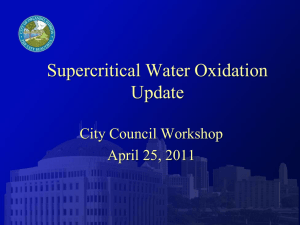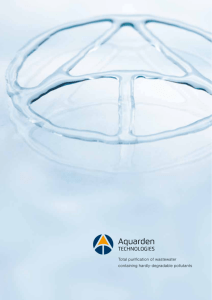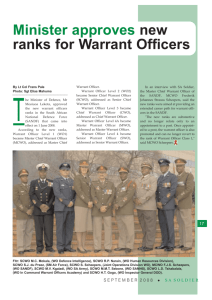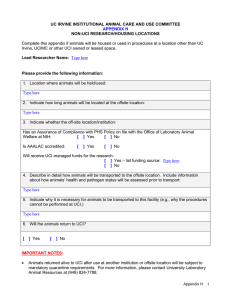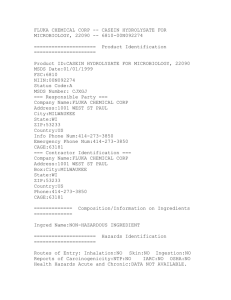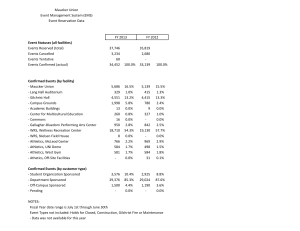REPORT BRIEF IN
advertisement
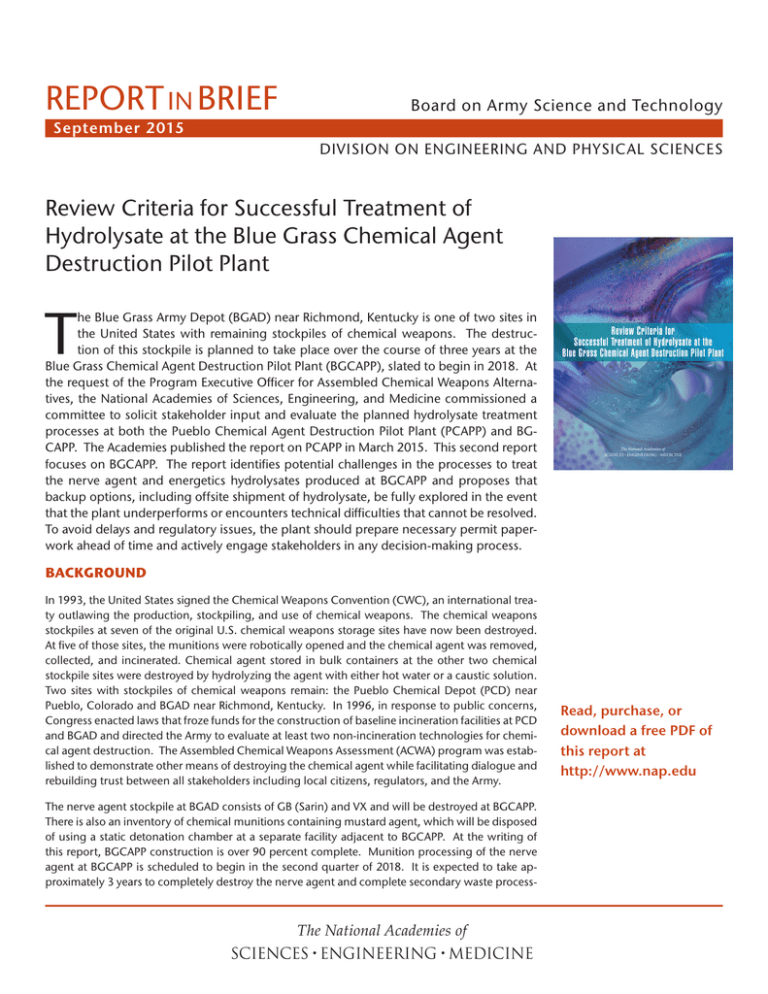
REPORT IN BRIEF Board on Army Science and Technology September 2015 DIVISION ON ENGINEERING AND PHYSICAL SCIENCES Review Criteria for Successful Treatment of Hydrolysate at the Blue Grass Chemical Agent Destruction Pilot Plant T he Blue Grass Army Depot (BGAD) near Richmond, Kentucky is one of two sites in the United States with remaining stockpiles of chemical weapons. The destruction of this stockpile is planned to take place over the course of three years at the Blue Grass Chemical Agent Destruction Pilot Plant (BGCAPP), slated to begin in 2018. At the request of the Program Executive Officer for Assembled Chemical Weapons Alternatives, the National Academies of Sciences, Engineering, and Medicine commissioned a committee to solicit stakeholder input and evaluate the planned hydrolysate treatment processes at both the Pueblo Chemical Agent Destruction Pilot Plant (PCAPP) and BGCAPP. The Academies published the report on PCAPP in March 2015. This second report focuses on BGCAPP. The report identifies potential challenges in the processes to treat the nerve agent and energetics hydrolysates produced at BGCAPP and proposes that backup options, including offsite shipment of hydrolysate, be fully explored in the event that the plant underperforms or encounters technical difficulties that cannot be resolved. To avoid delays and regulatory issues, the plant should prepare necessary permit paperwork ahead of time and actively engage stakeholders in any decision-making process. BACKGROUND In 1993, the United States signed the Chemical Weapons Convention (CWC), an international treaty outlawing the production, stockpiling, and use of chemical weapons. The chemical weapons stockpiles at seven of the original U.S. chemical weapons storage sites have now been destroyed. At five of those sites, the munitions were robotically opened and the chemical agent was removed, collected, and incinerated. Chemical agent stored in bulk containers at the other two chemical stockpile sites were destroyed by hydrolyzing the agent with either hot water or a caustic solution. Two sites with stockpiles of chemical weapons remain: the Pueblo Chemical Depot (PCD) near Pueblo, Colorado and BGAD near Richmond, Kentucky. In 1996, in response to public concerns, Congress enacted laws that froze funds for the construction of baseline incineration facilities at PCD and BGAD and directed the Army to evaluate at least two non-incineration technologies for chemical agent destruction. The Assembled Chemical Weapons Assessment (ACWA) program was established to demonstrate other means of destroying the chemical agent while facilitating dialogue and rebuilding trust between all stakeholders including local citizens, regulators, and the Army. The nerve agent stockpile at BGAD consists of GB (Sarin) and VX and will be destroyed at BGCAPP. There is also an inventory of chemical munitions containing mustard agent, which will be disposed of using a static detonation chamber at a separate facility adjacent to BGCAPP. At the writing of this report, BGCAPP construction is over 90 percent complete. Munition processing of the nerve agent at BGCAPP is scheduled to begin in the second quarter of 2018. It is expected to take approximately 3 years to completely destroy the nerve agent and complete secondary waste process- Read, purchase, or download a free PDF of this report at http://www.nap.edu ing, with operations scheduled to be completed in the second quarter of 2021. THE TREATMENT PROCESS As the first step in the BGCAPP treatment process, caustic hydrolysis will be used to destroy the agents and energetics. The hydrolysis process will result in a secondary waste stream known as hydrolysate. Both agent and energetics hydrolysates will be generated. These hydrolysates are very caustic but contain only hydrolysis products, not the original agents and energetics. The hydrolysates will be combined in specific ratios and treated using a first-of-a-kind technology called supercritical water oxidation (SCWO). SCWO reactors will subject the hydrolysate to very high temperatures and pressures, causing the organic materials within the hydrolysate to break down into carbon dioxide, water, and salts. The effluent from the SCWO reactors will be sent to a water recovery system (WRS) that will separate salts from water through reverse osmosis (RO). The end products of this process are water, a portion of which will be reused for quench water in the SCWO reactors, and non-toxic brine, which will be sent offsite for disposal. CRITERIA FOR SUCCESSFUL HYDROLYSATE TREATMENT The primary criteria for successful treatment of hydrolysate involve meeting regulatory and CWC requirements and meeting process performance and schedule goals for hydrolysate treatment. Performance goals consist mostly of quantitative expectations for SCWO and WRS performance based on the results of past testing, modeling, and analysis by BGCAPP and its contractors. The committee anticipates that these goals may be modified during preoperational testing and systemization. Systemization is “the testing of all process components, subsystems, and systems, and the demonstration that the plant, procedures, and personnel are ready for toxic operations.”1 A failure to meet some or many of the goals, while it may impact process performance, schedule, and costs, would not necessarily result in offsite shipment. However, if modifications made during preoperational testing to achieve these goals do not result in improved performance, then consideration of offsite transport would become more likely. RECOMMENDATION: The ability to meet the initial performance goals established by BGCAPP for SCWO and the WRS should be verified as a result of testing during systemization. POTENTIAL CHALLENGES SCWO System BGCAPP scientists and engineers have identified a number of challenges that may be encountered in the operation of the SCWO system at BGCAPP, including how it operates with actual hydrolysates rather than simulants and related issues of corrosion, and hydrolysate blend recipe. At this time the committee believes that the BGCAPP project staff are taking appropriate corrective action to address these challenges. Nevertheless, the SCWO system is Systemization Implementation Plan (Richmond, KY: BGCAPP Program Office, 2012) 1 complex and has a number of components, all of which have to operate in unison for hydrolysate to be effectively destroyed in a timely manner. A SCWO Working Group is addressing the gaps in knowledge, experience, and performance in the SCWO process by providing recommendations for closing these gaps and producing a plan for implementing these recommendations. RECOMMENDATION: The SCWO Working Group plan, as described in the December 17, 2014 Systemization Planning Report, and recommendations for correcting potential gaps in the October 27, 2014 Working Group report should be aggressively implemented. Furthermore, the SCWO Working Group should continue to provide support to all risk mitigation activities involving SCWO operations at BGCAPP. While previous testing established reactor downtimes and maintenance cycles, these tests were only conducted on simulated hydrolysate streams and were conducted over relatively short periods of time compared to the expected three-year destruction schedule at BGCAPP. If performance requirements and goals cannot be met consistently and satisfactorily, it may become necessary to consider shipping some or all of the hydrolysate or SCWO effluent offsite for disposal elsewhere. WRS System The WRS influent will be comprised of two combined streams: SCWO effluent, and cooling tower and steam blowdown water. These streams will be high in total dissolved solids, making RO an attractive process for treating the water so that it can be reused as quench water for the SCWO reactors. Although RO is an established treatment technology for high total dissolved solids waters, the SCWO effluent is a unique feed for RO and poses some treatment challenges. The successful operation of the current WRS direct filtration multimedia pretreatment system and the RO units is uncertain, largely due to unknown factors in the WRS process chemistry such as the amount of solids that will be in the SCWO effluent and the amount of solids that may settle in the SCWO effluent storage tanks. The coagulant requirements and effectiveness are also unclear. RECOMMENDATION: Well-planned pre-operational testing should be performed with actual SCWO effluent, or a realistic simulant, to establish operating conditions for effective pretreatment, and to determine if the WRS system, especially the multimedia direct filtration system, will perform as expected. In particular, preoperational testing should determine the solids loading and corresponding coagulant requirements for effective pretreatment. Serious consideration should be given to forming a WRS working group analogous to the SCWO Working Group. REDUCING UNCERTAINTY It is expected that extensive pre-operational activities involving the SCWO and the WRS will be performed concurrently with systemization to help reduce the uncertainty in expected technological performance. However, considering the first-of-a-kind nature of these technologies and the need for them to properly function in tandem, there is a possibility that technological issues with these systems may prevent BGCAPP from meeting its overall performance criteria, either at the beginning or over the course of operations. If problems occur, the destruction of the BGAD stockpile may need to be halted unless there is an alternative means for treating the hydrolysate. Given that the nerve agent munitions at BGAD have been stored for over 50 years, delays in the destruction process would protract the risk to the local community. Therefore, it is necessary to establish a backup plan so that the destruction of the BGAD stockpile can continue in the event of technological issues. RECOMMENDATION: Considering that the SCWO and the WRS may not perform satisfactorily and that this under performance could result in delays in the destruction of chemical agent at BGCAPP, increasing the primary risk to the community associated with continued munitions storage, BGCAPP should establish a backup plan as an alternative to the onsite hydrolysate treatment processes. Should SCWO or WRS problems develop, substantial storage capacity exists at BGCAPP, allowing time to improve performance while agent destruction continues. Hence, BGCAPP would likely have time to resolve any SCWO or WRS problems as neutralization continues. Only if hydrolysate storage nears capacity, or if problems appear unsolvable, would it become necessary to consider a backup plan. One alternative that would likely be more readily implemented than others would be to ship the hydrolysate offsite. OFFSITE SHIPMENT AS A CONTINGENCY OPTION A decision to ship hydrolysate offsite could seriously affect stakeholders, BGCAPP operations, regulatory compliance, and obligatory requirements under the Chemical Weapons Convention. There could be even more negative repercussions in the event that BGCAPP is not prepared ahead of time for a possible transition to offsite shipment. RECOMMENDATION: Although the SCWO and WRS appear to be capable of processing hydrolysate at BGCAPP, and a comprehensive preoperational testing program to improve performance will be undertaken, there is still a reasonable possibility that at some point during BGCAPP operations, a decision may need to be made to ship hydrolysate or SCWO effluent offsite. As a precaution, BGCAPP management should be prepared for this contingency by taking all necessary preparatory actions having long lead times well in advance of such a decision. Any effort to implement offsite transport will be considerable. Should the decision be made to ship hydrolysate or SCWO effluent offsite, it would require physical changes to the plant infrastructure, changes in permit documentation and standard operating procedures, transportation risk assessments, and staffing changes. Likewise, the effort to shift back to onsite treatment would also be substantial. At this time, it is not possible to predict the exact circumstances of possible SCWO or WRS underperformance or failure. The evaluation of whether to ship offsite permanently, temporarily, or in a parallel manner is more appropriately made among decision makers and stakeholders when the specific circumstances are known. While hydrolysates and similar fluids have been shipped offsite from other chemical demilitarization facilities without incident, it is still possible that a transportation crash or incident could occur. However, it is important to understand that the hazard posed by hydrolysate is not from the presence of chemical agent, which is destroyed during the hydrolysis process, but from the caustic nature of the hydrolysate. The dangers posed by potential hydrolysate exposure are modest in comparison to other similarly categorized corrosive materials. STAKEHOLDER CONCERNS Public involvement has been a critical component of the ACWA program since its inception, and the concerns of the community would be a key consideration in any offsite decision process. The community around BGCAPP is represented primarily by the Citizens’ Advisory Commission (CAC) and the Chemical Destruction Citizens’ Advisory Board (CDCAB), an independent subcommittee of the CAC. The CAC is comprised of nine members appointed COMBINED SCWO AND WRS FAILURE SCENARIOS SCWO WRS CONTINGENCY OPTIONS Functions Functions Continue operations as planned Functions Fails to treat SCWO effluent, but functions for cooling tower steam and blowdown water Option 1 • Continue to process hydrolysate with SCWO, but ship SCWO effluent offsite • Continue processing blowdown in WRS for use as quench water in SCWO • Supplement SCWO quench water with demineralized BGAD water as needed Option 2 • Halt both SCWO and WRS operations and send hydrolysate offsite Functions Fails to treat SCWO effluent and cooling tower steam and blowdown water Option 1 • Continue to process hydrolysate with SCWO, but ship SCWO effluent and blowdown offsite for disposal • Use demineralized BGAD water for SCWO quench water Option 2 • Halt both SCWO and WRS operations and send hydrolysate offsite Fails Functions Halt both SCWO and WRS operations and send hydrolysate offsite Fails Fails Halt both SCWO and WRS operations and send hydrolysate offsite by the state governor, while the CDCAB allows for broader stakeholder involvement from local organizations including medical, emergency management, university, and school representatives. Despite initial challenges, the CAC/CDCAB, ACWA, and BGCAPP have built a solid working relationship. The public involvement process at BGCAPP is well established and includes a variety of opportunities for stakeholders to obtain information and become involved in project activities and decisions. Should operational issues arise at BGCAPP, this working relationship will provide a strong basis for continued and meaningful public involvement. The CAC/CDCAB recognizes that the chemical munitions at BGAD must be destroyed as soon and safely as possible. They view onsite treatment with hydrolysis followed by the SCWO and WRS technologies as a commitment made to the community. The CAC/ CDCAB maintain that offsite hydrolysate shipment would only be acceptable if it were the only alternative, and should be temporary until BGCAPP systems are back online. Most important for the CAC/CDCAB, however, is that they continue to be involved in the decision process. RECOMMENDATION: In collaboration with the CAC/CDCAB, the Program Executive Office for Assembled Chemical Weapons Alternatives should institutionalize a transparent consultation process that builds on the existing foundation and working group structure to ensure meaningful stakeholder input into analyses, evaluations, and decision criteria related to potential offsite shipment of hydrolysate and that provides opportunities for engaging with communities that would receive hydrolysate. REGULATORY ISSUES Applicable regulations governing any potential offsite shipment of hydrolysate or SCWO effluent include the Resource Conservation and Recovery Act (RCRA), as administered by the Kentucky Department for Environmental Protection (KDEP) and the EPA, and the National Environmental Policy Act (NEPA). RCRA permitting requirements provide the greatest challenge for BGCAPP. The challenge is made greater by the unique situation in Kentucky where the state legislative language pertaining to chemical agent would currently classifies waste derivatives, such as hydrolysate and SCWO effluent, as acutely toxic wastes, the same as the original agent. This acute toxicity designation would impose stringent requirements for management of these wastes that are burdensome and unnecessary. The CAC/CDCAB, in coordination with BGCAPP, is presently pursuing legislative changes that would alleviate this situation. Another complication in Kentucky stems from the manner in which the BGCAPP RCRA permit is structured. BGCAPP is permitted under a RCRA Research, Development and Demonstration (RD&D) permit for destruction of GB, but is intended to switch to a conventional RCRA Part B permit for destruction of the VX. Should SCWO be abandoned during the RD&D phase, the RD&D permit would no longer be applicable and BGCAPP would have to switch to a Part B permit earlier than planned. Significantly, should hydrolysate or even SCWO effluent need to be shipped offsite, under either the current RD&D or a Part B permit, a year or more would likely be required to process the required permit modifications. RECOMMENDATION: As a backup plan [should onsite hydrolysate treatment processes underperform], BGCAPP should revise its RCRA Part B permit application currently being prepared for the disposal of VX munitions to allow for the possibility of offsite transport of VX agent, GB agent and energetics hydrolysates, as well as spent decontamination solution and SCWO effluent, should the SCWO or WRS process be shown to be irreparable. RECOMMENDATION: As a backup plan [should onsite hydrolysate treatment processes underperform], BGCAPP should consult with KDEP concerning whether the RCRA RD&D permit could be modified to allow the temporary offsite transport of GB hydrolysate (i.e., until the SCWO can be brought back on line) or for the temporary or permanent offsite transport of SCWO effluent, should the WRS process be shown to be irreparable. The key point is that regulatory delays not impact the destruction of agent at BGCAPP. Accordingly, the committee believes that RCRA permit modifications and other environmental documentation that support the potential for offsite shipment as a backup plan need to be prepared expeditiously, and discussed with all stakeholders. COMMITTEE ON REVIEW CRITERIA FOR SUCCESSFUL TREATMENT OF HYDROLYSATE AT THE PUEBLO AND BLUE GRASS CHEMICAL AGENT DESTRUCTION PILOT PLANTS: Todd A. Kimmell, Argonne National Laboratory, Chair; Edward J. Bouwer, Johns Hopkins University; Judith A. Bradbury, Pacific Northwest Laboratory (retired); Rebecca A. Haffenden, Argonne National Laboratory; Kimberly L. Jones, Howard University; Murray G. Lord, Dow Chemical Company; Douglas M. Medville, The MITRE Corporation (retired); Trisha H. Miller, Sandia National Laboratories; Robert Puyear, Union Carbide (retired); William R. Rhyne, ABS Consulting, Inc. (retired); Phillip E. Savage, Penn State University; Philip C. Singer, NAE, University of North Carolina, Chapel Hill (retired); Seth Tuler, Worcester Polytechnic Institute STAFF: James C. Myska, Study Director; Nia D. Johnson, Senior Research Associate; Deanna P. Sparger, Program Administrative Coordinator This study was supported by the Program Executive Office for Assembled Chemical Weapons Assessment. Any opinions, findings, conclusions, or recommendations expressed in this publication are those of the author(s) and do not necessarily reflect the views of the organizations or agencies that provided support for the project. Copies of this report are available free of charge from http://www.nap.edu. Report issued September 2015. Permission granted to reproduce this brief in its entirety with no additions or alterations. Permission for images/figures must be obtained from their original source. © 2015 The National Academy of Sciences
